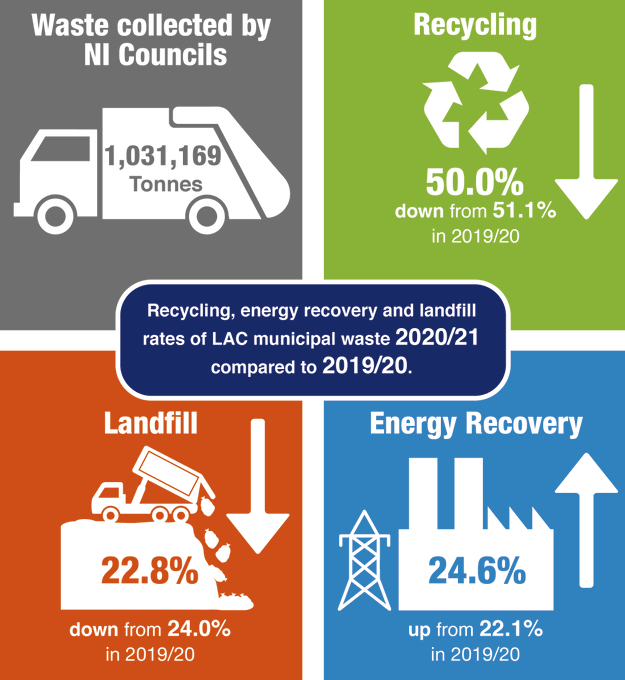The latest annual Local Authority Collected (LAC) Waste statistics from the Department of Agriculture, Environment and Rural Affairs (DAERA) highlights the growing challenge to manage Northern Ireland’s waste sustainably. This latest data for the year 2020/21 shows that waste arisings from Council collected waste broke the 1 million tonne barrier for the first time in over 10 years. Waste arisings have increased year on year with Northern Ireland’s councils collecting 1,031,169 tonnes of waste during 2020/21 which was 3.2 per cent higher than that collected in 2019/20 (998,985 tonnes). Since a low point of 913,546 in 2012/13, we have seen a steady increase in total arisings with a 12.9 per cent increase recorded over the last eight years.
The statistics also indicate a stalling in recycling levels from the same period last year. During 2020/21, 50.0 per cent of waste collected by councils was sent for recycling, 1.1 per cent lower than the recycling rate for 2019/20. Taken together this means that there is even more waste that needs to be treated.
At the same time, the latest figures show that while there has been a small reduction in the amount of waste sent to landfill from 240,220 to 234,956 tonnes between 2019/20 and 2020/21, it is clear that this is largely being achieved by an increase in NI waste being sent for energy recovery.
In 2020/21, 253,180 tonnes of NI waste arisings were sent for energy recovery. This gave an energy recovery rate of 24.6 per cent, higher than the 22.1 per cent recorded in 2019/20. The report does not however point out that the vast majority of this energy recovery is currently achieved via exporting Northern Ireland waste at great environmental and financial cost for others to benefit from its energy and resource potential.
Speaking about the latest annual waste data statistics John Ahern, Indaver UK and Ireland, the European waste management experts planning to invest £240m in integrated waste management infrastructure to meet the needs of six NI councils said;
“These latest Council waste figures show that NI has breached 1 million tonnes of waste arisings, highlighting the scale of the challenge we all face. “The data reinforces the need to deliver additional robust and integrated waste management infrastructure locally, especially to deal with our residual, non-recyclable waste. If we don’t, we risk stumbling into a waste crisis of our own making. The importance of ending waste to landfill was emphasised as part of the recent COP26 pledge to tackle harmful methane emissions as a means of tackling global warming in the shorter term.
“While there has been a small reduction in the amount of waste being sent to landfill it is clear that this is only happening due to a significant increase in waste being sent for energy recovery. While this indicates an acceptance of the important role of energy recovery in sustainably managing residual waste, the statistics don’t tell the whole story as the vast majority of this energy recovery is currently happening abroad. We continue to ship increasing volumes of our waste at significant financial and environmental cost to Europe and further afield – meaning the value from that waste is being utilised elsewhere. This clearly runs contrary to the proximity principles which say that waste should be treated close to where it is generated and is entirely illogical at a time when we also continue to import fossil fuels to meet our local energy needs,” he concluded
The proposed arc21 infrastructure will directly contribute to Northern Ireland’s Net Zero Carbon and Circular Economy Package targets which include a 10% cap on landfill by 2035. This will be achieved by firstly increasing recycling levels from black bin waste by up to 10%, diverting waste from landfill and then generating valuable energy locally from the remaining non-recyclable waste.
The arc21 project has been in the planning system for over 7 years now and the latest statistics highlight the challenge and demonstrate that the need for the project is even greater than ever.



